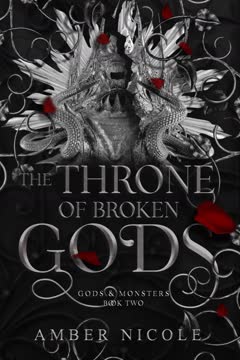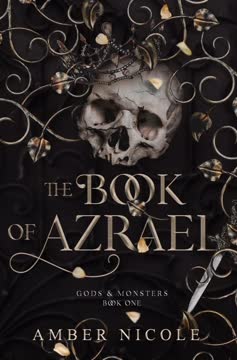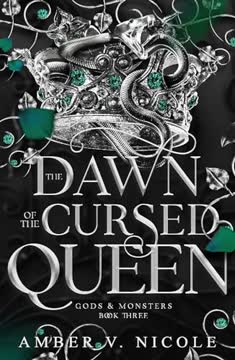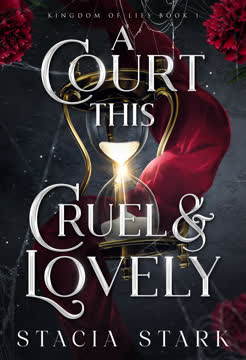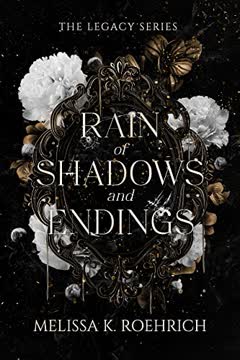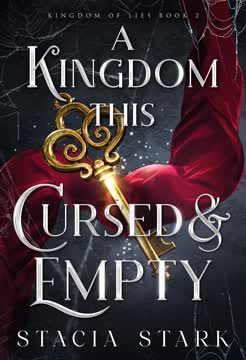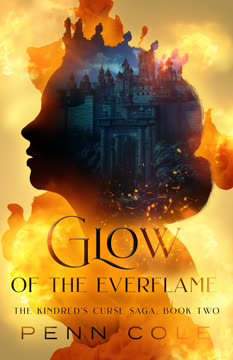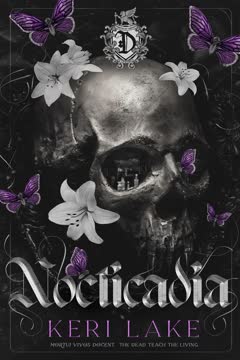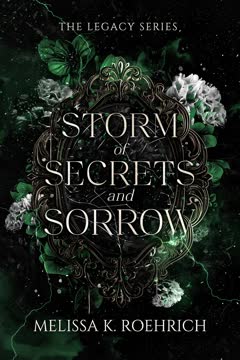Plot Summary
Shattered Promises, Broken Kings
The story opens in the aftermath of devastation. Samkiel, the immortal World Ender, is haunted by the loss of Dianna, a woman who cracked the ice around his heart. The world reels from the chaos unleashed by gods and monsters, and Samkiel is forced to confront his own failures as a king and protector. Dianna, meanwhile, is consumed by grief and rage after her sister's death, her powers spiraling out of control. Both are isolated, broken, and searching for meaning in a world that has betrayed them.
Vengeance Unleashed
Dianna's pain becomes a weapon. She hunts those responsible for her sister's death, leaving a trail of blood and ash. Her humanity slips as she feeds on mortals and unleashes her Ig'Morruthen power, becoming a force of vengeance feared by all. Samkiel, desperate to save her from herself, is torn between his duty to the world and his love for her. Their paths cross in violence and heartbreak, each trying to reach the other through the armor of pain.
The House of Chains
Haunted by dreams and memories, Dianna is trapped in a mental house of locked doors and chains, each representing trauma and suppressed power. Gabby, her lost sister, appears in visions, urging her to confront her guilt and grief. Dianna's journey through this house is a battle with herself, unlocking the truth of her own heart and the source of her strength.
Blood and Betrayal
The world's protectors, The Hand, are torn apart by betrayal. Vincent, Cameron, and others are manipulated or coerced into serving Kaden, the true architect of chaos. Dianna's friends become her jailors, and Samkiel's family is ripped from him. The lines between love and loyalty blur as each character is forced to choose between their heart and their survival.
The Gathering Storm
The opening of the realms unleashes ancient gods and monsters. Nismera, a goddess of war and destruction, returns with an army, threatening to consume all. The council, once trusted, is revealed as traitors serving The Order. Samkiel is betrayed, captured, and tortured, his power used to open the gates of chaos. Dianna, powerless and alone, must find the strength to fight for those she loves.
Monsters and Family
Amidst the chaos, the characters seek solace in each other. Dianna finds unexpected friendship and acceptance among The Hand, learning that family is not just blood but those who stand by you. Samkiel, too, realizes that his true strength comes from those he loves, not the crown he wears. Together, they begin to heal, sharing laughter, pain, and hope.
The Price of Resurrection
Samkiel is killed by Kaden and Nismera, his life force used to open the realms. Dianna, devastated, confronts her deepest fears and guilt. Guided by Gabby and the fate Roccurem, she learns that resurrection has a cost. Through the ritual of the Mark of Dhihsin—blood, body, and soul—she brings Samkiel back, binding their souls together at great personal risk.
The Council's Treachery
The council, corrupted by The Order, imprisons Samkiel and turns The Hand into emotionless weapons. Allies become enemies, and the last protectors of the world are lost. The true history of the gods is revealed: Kaden is Samkiel's brother, a son of Unir, and the architect of the world's suffering. The council's ambition and fear threaten to destroy everything Samkiel and Dianna have fought for.
The Mark of Dhihsin
The Mark of Dhihsin, a soul-bond between true mates, becomes the key to salvation. Dianna and Samkiel's love, forged in pain and sacrifice, transcends death and prophecy. Their bond is both a weapon and a shield, granting them the power to stand against the darkness. But the mark comes with a price, and the world will never be the same.
The End of Guardians
With the realms open and the gods unleashed, the era of guardians and kings ends. The Hand, once Samkiel's loyal protectors, are scattered or enslaved. The world is left vulnerable, and the future is uncertain. Samkiel and Dianna must face the consequences of their choices and the legacy of those who came before.
The World Unravels
Nismera's army sweeps across the realms, and the world teeters on the brink of annihilation. Samkiel and Dianna, battered and broken, are all that stand between life and oblivion. Their love is tested as they confront the true enemy and the cost of their own power. The fate of all worlds hangs in the balance.
Love Beyond Death
In the darkest hour, love becomes the world's last hope. Dianna forgives herself and accepts the love of those around her. Samkiel, resurrected by her sacrifice, finds peace in her arms. Together, they inspire others to fight, to hope, and to believe in a future beyond pain. The story ends not with victory, but with the promise of healing and the dawn of a new era.
The Last Light
As the dust settles, the survivors gather to mourn, to celebrate, and to rebuild. The old world is gone, but a new one is born from the ashes. Samkiel and Dianna, soul-bound and forever changed, lead the way into an uncertain future. The lessons of love, sacrifice, and family endure, lighting the path ahead.
The True Enemy Revealed
The truth of Kaden's origin and the manipulations of The Order are laid bare. The gods' own hubris and fear created the monsters that now threaten all existence. The real enemy is not just Kaden or Nismera, but the cycle of violence and betrayal that began with the first gods. Breaking that cycle requires more than power—it requires forgiveness and the courage to love.
The Choice of Sacrifice
Dianna is forced to choose between vengeance and saving those she loves. Guided by Gabby's spirit, she chooses selflessness, breaking the chains of her own pain. The act of sacrifice, of choosing love over hate, becomes the turning point in the battle for the world's soul.
The New Dawn
The story closes with the promise of a new beginning. The survivors, scarred but hopeful, look to the future. Samkiel and Dianna, united by the Mark of Dhihsin, lead the way. The world is forever changed, but the lessons of love, forgiveness, and family endure. The dawn breaks on a world where monsters and gods are no longer the only rulers—where hope, at last, has a place.
Characters
Dianna (Mer-Ka/Ayla)
Dianna is the heart of the story—a woman forged in trauma, loss, and betrayal. Adopted into a mortal family, she is later revealed to be the daughter of Azrael, a celestial, and the prophesied mate of Samkiel. Her journey is one of grief, rage, and ultimately, self-forgiveness. She is both monster and savior, her Ig'Morruthen power a reflection of her pain and her capacity for love. Dianna's relationships—with her sister Gabby, with Samkiel, and with her found family—define her. Her greatest fear is abandonment, and her greatest strength is her willingness to sacrifice everything for those she loves. Through her, the story explores the cost of vengeance, the possibility of redemption, and the healing power of love.
Samkiel (Liam, World Ender)
Samkiel is the last true guardian of the realms, a god-king burdened by the failures of his father and the weight of impossible expectations. He is both feared and revered, but beneath the armor is a man desperate for connection and meaning. His love for Dianna cracks the ice around his heart, teaching him vulnerability and hope. Samkiel's journey is one of self-acceptance—learning that his worth is not in his power or his crown, but in his capacity to love and be loved. His resurrection, made possible by Dianna's sacrifice, is the story's emotional climax, symbolizing the triumph of love over death and fate.
Kaden
Kaden is revealed as Samkiel's brother, a son of Unir, and the true architect of the world's suffering. Twisted by jealousy, love, and the manipulations of The Order, Kaden is both monster and victim. His obsession with Dianna and his desire for power drive the story's central conflict. Kaden's actions are rooted in a desperate need for belonging and recognition, making him a complex and tragic antagonist. His downfall is a warning about the dangers of unchecked ambition and the corrosive power of envy.
Gabby (Gabriella)
Gabby is Dianna's adopted sister, her anchor to humanity and her moral compass. Her death is the catalyst for Dianna's descent into vengeance and the story's central tragedy. In dreams and visions, Gabby guides Dianna toward forgiveness and self-acceptance, reminding her that love is stronger than pain. Gabby's presence is a symbol of hope, family, and the enduring power of memory.
The Hand (Logan, Neverra, Cameron, Xavier, Imogen, Vincent)
The Hand are Samkiel's chosen family and the world's last line of defense. Each member is defined by loyalty, love, and the scars of battle. Logan and Neverra's love story mirrors Samkiel and Dianna's, while Cameron and Xavier's unspoken bond is a tale of missed chances and heartbreak. Imogen is the voice of reason and empathy, and Vincent is the embodiment of fear and betrayal. The Hand's journey is one of loss, forgiveness, and the search for a new purpose in a world without guardians.
Roccurem (Reggie)
Roccurem is a fate, bound by ancient laws to serve the true king but secretly working to help Dianna and Samkiel. He is both guide and manipulator, his actions driven by a desire to repay a debt to Unir. Roccurem's interventions are crucial to the story's resolution, but his allegiance is always in question. He represents the tension between destiny and free will, and the possibility of redemption even for those bound by fate.
Nismera
Nismera is the story's ultimate antagonist—a goddess of unimaginable power and cruelty. Her return signals the end of the old order and the beginning of a new era of chaos. Nismera's hatred for Samkiel and Dianna is personal, rooted in ancient betrayals and the cycle of violence that began with the first gods. She is both a force of nature and a cautionary tale about the dangers of unchecked power.
Azrael
Azrael is Dianna's true father, a celestial who tried to save his daughter by hiding her among mortals. Manipulated and enslaved by Kaden and The Order, Azrael is a tragic figure—a once-great warrior reduced to a puppet. His love for Dianna is real, but his actions are shaped by fear and regret. Azrael's story is a meditation on the limits of love and the cost of secrets.
The Order (Elianna, Jiraiya, Leviathan, Tora, Rolluse)
The Order is the hidden hand behind the world's suffering, a council corrupted by fear and ambition. Their betrayal of Samkiel and The Hand is the story's central act of treachery, and their alliance with Kaden and Nismera unleashes the final catastrophe. The Order represents the dangers of power without accountability and the ease with which good intentions can become evil.
The Irvikuva
The Irvikuva are the monstrous offspring of Kaden's experiments, creatures of blood and darkness. They are both weapons and victims, their existence a testament to the consequences of unchecked ambition and the perversion of power. The Irvikuva are a constant threat, but also a reminder of the world's capacity for both creation and destruction.
Plot Devices
Dual Protagonists and Interwoven Narratives
The novel's structure alternates between Dianna and Samkiel's perspectives, allowing readers to experience both the internal and external conflicts that drive the story. Their parallel journeys—one of vengeance, the other of redemption—mirror and inform each other, culminating in their soul-bond and the story's emotional climax.
The House of Chains and Locked Doors
Dianna's recurring dreams of a house filled with locked doors and chains serve as a powerful metaphor for her psychological state. Each door represents a trauma or secret, and her journey through the house is a process of self-discovery and healing. The final unlocking of the door is both a literal and symbolic release of her true power.
The Mark of Dhihsin
The Mark of Dhihsin is the story's central magical device—a ritual of blood, body, and soul that binds true mates together. It is both a source of power and a symbol of love, its completion the key to resurrection and the defeat of fate. The mark's appearance and disappearance foreshadow the story's resolution and the cost of resurrection.
Betrayal and the Corruption of Power
The story is driven by a series of betrayals—by friends, family, and institutions. The council's treachery, The Hand's enslavement, and Kaden's manipulation of love and loyalty all serve to isolate the protagonists and raise the stakes. These betrayals are foreshadowed by early hints of corruption and the recurring theme of power's corrosive effects.
Prophecy, Fate, and Free Will
Prophecy and fate are constant forces in the story, embodied by Roccurem and the manipulations of The Order. The characters struggle to break free from the chains of destiny, and the story's resolution hinges on the choice to love and forgive rather than to seek vengeance. The ultimate message is that fate can be rewritten, but only at great personal cost.
Resurrection and the Cost of Magic
The resurrection of Samkiel is the story's emotional and narrative climax, made possible by Dianna's sacrifice and the completion of the Mark of Dhihsin. The act of resurrection is foreshadowed by earlier discussions of the mark, the story of Gathrriel and Vvive, and the recurring theme of love's power to defy death. The cost of resurrection—personal, magical, and cosmic—is a central question, and the story does not shy away from the consequences.
Found Family and the Redefinition of Home
The story repeatedly challenges the idea that blood is the only bond that matters. Dianna's adoption, her relationship with Gabby, and the formation of new bonds with The Hand all serve to redefine family as a matter of choice, loyalty, and love. The theme is reinforced by the destruction and rebuilding of homes, both literal and metaphorical.
Analysis
The Throne of Broken Gods is a sweeping fantasy that uses the language of gods and monsters to explore deeply human questions: How do we survive loss? Can we forgive ourselves for the choices we make in pain? Is love enough to heal what is broken? The novel's central message is that true strength is not found in power or vengeance, but in vulnerability, forgiveness, and the willingness to love even when it hurts. The story's complex structure—interweaving personal trauma, cosmic battles, and political intrigue—mirrors the psychological reality of its characters. The use of dreams, locked doors, and soul-bonds as metaphors for healing and connection is both powerful and accessible, allowing readers to see themselves in the struggles of gods and monsters alike. Ultimately, the book is a testament to the resilience of the human (and inhuman) heart, and a call to choose love, even when the world is ending.
Last updated:
FAQ
Synopsis & Basic Details
What is The Throne of Broken Gods about?
- A World Shattered by Betrayal: The Throne of Broken Gods plunges into a realm reeling from cosmic devastation, where ancient gods and monstrous forces clash. It follows Samkiel, the immortal World Ender, burdened by past failures and a shattered heart, and Dianna, an Ig'Morruthen consumed by grief and vengeance after her sister Gabby's death.
- Love Forged in Chaos: The narrative explores their complex, volatile relationship as Samkiel desperately tries to save Dianna from her destructive path, while she hunts those responsible for her pain. Their intertwined journeys reveal hidden truths about their origins, the nature of their powers, and the deep-seated betrayals that threaten to unravel all realms.
- A Battle for Redemption: Beyond personal vendettas, the story escalates into a war against Kaden, Samkiel's manipulative brother and a general of the ancient Order, and the re-emerged goddess Nismera. It delves into themes of destiny versus free will, the cost of power, and the transformative, redemptive power of love and found family in the face of overwhelming darkness.
Why should I read The Throne of Broken Gods?
- Emotionally Charged Character Arcs: Readers seeking deep psychological exploration will find Dianna's journey through grief and vengeance, and Samkiel's struggle with his identity and capacity for love, incredibly compelling. The narrative doesn't shy away from the raw, messy aspects of healing and self-acceptance.
- Intricate World-Building & Lore: The book offers a rich tapestry of ancient gods, hidden realms, and complex prophecies, expanding on the mythology introduced in previous books. It subverts typical fantasy tropes by exploring the moral ambiguities of "good" and "evil" deities.
- Dynamic, High-Stakes Romance: The central relationship between Dianna and Samkiel is a fiery, passionate, and often brutal dance between two powerful beings. Their push-and-pull dynamic, filled with witty banter and profound emotional connection, makes for an addictive read, exploring how love can heal even the deepest wounds.
What is the background of The Throne of Broken Gods?
- Cosmic History & Ancient Conflicts: The world is shaped by a long history of inter-realm wars and the rise and fall of powerful gods, particularly the reign of Unir, Samkiel's father, who sealed the realms. This background establishes a universe where power dynamics are constantly shifting and ancient grudges run deep, influencing current events.
- Technological & Cultural Blend: Onuna, the primary mortal realm, showcases a blend of advanced technology (televised news, surveillance, modern cities) and ancient magical practices. This juxtaposition highlights the ongoing tension between mortal progress and the timeless, often destructive, forces of the Otherworld.
- The Legacy of the Old Gods: The narrative is steeped in the consequences of past divine actions, particularly Unir's choices regarding his children and the sealing of the realms. This creates a pervasive sense of inherited burden and destiny, where characters grapple with the sins and secrets of their powerful ancestors.
What are the most memorable quotes in The Throne of Broken Gods?
- "You are pure, blinding energy. You make my entire being tingle. Do you feel it too? Do you feel me?": This quote from Dianna (Chapter 5) during her confrontation with Samkiel encapsulates their undeniable, raw connection, highlighting the intense physical and emotional pull that transcends their animosity and foreshadows their soul-bond.
- "If you love something, set it free. If it comes back—": Roccurem's fragmented wisdom (Chapter 36) to Samkiel, a classic literary allusion, subtly hints at the nature of true love and free will within the story's deterministic prophecies, emphasizing the choice Dianna must make.
- "You are better than any destiny.": Samkiel's profound declaration to Dianna (Chapter 81) directly challenges the pervasive theme of fate and prophecy, asserting the power of individual choice and love over predetermined paths, offering a powerful message of hope and self-worth.
What writing style, narrative choices, and literary techniques does Amber V. Nicole use?
- Dual Protagonists and Interwoven Narratives: The narrative primarily alternates between Samkiel and Dianna's first-person perspectives, offering deep immersion into their individual psychological states and emotional turmoil. This choice allows readers to experience their internal conflicts, motivations, and evolving feelings directly, enhancing character empathy.
- Sensory-Rich & Visceral Language: Nicole employs vivid, often raw, sensory descriptions, particularly in depicting violence, emotional pain, and intimate moments. Phrases like "scorching hot metal bit at my skin" (Chapter 1) or "blood thrummed in my ears" (Chapter 2) create a visceral reading experience, grounding the fantastical elements in tangible sensations.
- Recurring Motifs & Symbolism: The author frequently uses recurring motifs such as "locked doors in a house" (representing suppressed trauma), the Mark of Dhihsin (soul-bond, destiny), and elemental imagery (fire, storms, light, darkness) to symbolize character states, thematic conflicts, and the cosmic forces at play, enriching the symbolism in The Throne of Broken Gods.
Hidden Details & Subtle Connections
What are some minor details that add significant meaning?
- Samkiel's Counting of Minutes: In Chapter 1, Samkiel meticulously counts "twenty thousand, one hundred and sixty minutes" since Dianna left. This seemingly obsessive detail immediately establishes the depth of his attachment and the profound impact of her absence, revealing his hidden vulnerability and foreshadowing his later admission of how deeply he cares for her.
- Dianna's Pinky Promise: Dianna's "pinky promise" (Chapter 1, 2, 63) is a recurring, seemingly childish gesture that becomes a powerful symbol of her commitment and, later, her betrayal. When she uses it dismissively after Gabby's death, it highlights her emotional detachment, and when Samkiel later uses it to secure her promise to return (Chapter 63), it signifies her re-engagement with trust and connection.
- The Photo Booth Strip: The small strip of photos from the festival (Chapter 5, 35) that Samkiel keeps and Dianna later burns, then has re-made into a pendant (Chapter 78), is a subtle but potent symbol of their evolving relationship. It represents shared joy, Dianna's attempt to erase their connection in grief, and ultimately, her acceptance of their bond and the preciousness of their shared memories.
What are some subtle foreshadowing and callbacks?
- Roccurem's "Running Out of Time" Motif: Roccurem repeatedly tells Dianna and Samkiel they are "running out of time" (e.g., Chapter 8, 16, 25, 53, 85). Initially vague, this phrase subtly foreshadows the impending Equinox and the larger cosmic events tied to Samkiel's death and the realms' opening, building a sense of urgency and inevitability.
- The House of Chains and Locked Doors Metaphor: The recurring image of "a lock on a door in a house rattled/quieted" (e.g., Chapter 6, 8, 12, 35, 52, 56, 61, 66, 71) is a powerful callback to Dianna's internal "House of Chains." Each instance subtly indicates her emotional state, whether she is suppressing pain, allowing vulnerability, or confronting a buried truth, providing insight into her psychological journey.
- The Nature of Ig'Morruthen Power: Early descriptions of Dianna's power, particularly its destructive potential and connection to Kaden, subtly foreshadow the revelation of her true lineage and her role as Samkiel's "ruination" (Chapter 83). Her ability to "eat worlds" (Chapter 47) is a direct callback to the ancient Ig'Morruthen history revealed by Reggie (Chapter 24).
What are some unexpected character connections?
- Azrael as Dianna's Father: The revelation that Azrael, the celestial weapon-maker thought long dead, is Dianna's biological father (Chapter 85) is a major twist. This connection recontextualizes Dianna's unique powers and her ability to find the Book of Azrael, adding a layer of tragic irony to her adopted family's fate and her own destiny.
- Kaden as Samkiel's Brother: The shocking truth that Kaden is Samkiel's half-brother, a son of Unir (Chapter 83), completely redefines their conflict. This familial bond explains Kaden's deep-seated jealousy and obsession with Dianna, transforming him from a generic villain into a complex, tragic figure driven by a desperate need for paternal recognition and power.
- The Council's True Allegiance: The gradual reveal that the Council of Hadrameil, Samkiel's supposed allies, are actually part of "The Order" and serve a "true king" (Chapter 87) is an unexpected betrayal. This connection highlights the pervasive corruption within the established power structures and underscores Samkiel's profound isolation and the depth of the conspiracy against him.
Who are the most significant supporting characters?
- Roccurem (Reggie): Initially appearing as a cryptic, neutral fate, Roccurem evolves into a crucial, albeit reluctant, guide for Dianna and Samkiel. His interventions, though often veiled in riddles, are pivotal in revealing prophecies, facilitating their bond, and ultimately saving them from Nismera (Chapter 91), showcasing his complex role beyond mere observation.
- Neverra: More than just Logan's mate, Neverra becomes a vital emotional anchor for Dianna, particularly after Gabby's death. Her willingness to risk her life for Dianna (Chapter 46, 75) and her compassionate understanding of Dianna's grief (Chapter 51) are instrumental in breaking through Dianna's emotional walls, highlighting the theme of found family and unconditional support.
- Cameron & Xavier: Beyond their roles as Samkiel's loyal Hand, Cameron and Xavier provide crucial comic relief and emotional depth. Their banter and unspoken bond (Chapter 55, 59) offer a counterpoint to the story's darkness, while Xavier's personal trauma and Cameron's protective instincts reveal the human cost of their divine duties, making them relatable figures in a world of gods.
Psychological, Emotional, & Relational Analysis
What are some unspoken motivations of the characters?
- Dianna's Self-Punishment: Beyond vengeance, Dianna's extreme recklessness and willingness to be hurt (e.g., letting Seraphine beat her, Chapter 57) are unspoken manifestations of her survivor's guilt. She subconsciously believes she deserves punishment for Gabby's death, seeing herself as a "monster" and seeking to validate that self-perception.
- Samkiel's Fear of Abandonment: Samkiel's intense possessiveness and fear of Dianna leaving him (Chapter 31, 50, 62) stem from his deep-seated trauma of losing his family and world (Rashearim) and being abandoned by his father. His actions, though sometimes controlling, are driven by an unspoken terror of being alone again, making his Samkiel motivations complex.
- Kaden's Need for Validation: Kaden's relentless pursuit of power and his desire to "break" Dianna are rooted in his unspoken need for validation from his father, Unir. As Samkiel's unacknowledged brother, Kaden seeks to prove his worth and claim what he believes is rightfully his, making his villainy a tragic consequence of familial neglect.
What psychological complexities do the characters exhibit?
- Dianna's Emotional Suppression: Dianna exhibits profound emotional suppression, particularly after Gabby's death. She "locks away" her grief and pain behind metaphorical doors (Chapter 6, 8, 12, 35, 52, 56, 61, 66, 71), choosing anger and vengeance as coping mechanisms. This Dianna psychological analysis highlights the destructive nature of unaddressed trauma and the difficulty of allowing oneself to feel again.
- Samkiel's Burden of Perfection: Samkiel struggles with the immense psychological burden of being the "World Ender" and a perfect king. He feels he must always be strong, emotionless, and infallible, leading to self-imposed isolation and a fear of vulnerability. His internal conflict between duty and personal desire is a key aspect of his Samkiel character analysis.
- The Hand's Trauma Response: Members of The Hand, particularly Logan and Xavier, display complex trauma responses. Logan's compulsive checking of his Mark of Dhihsin (Chapter 34) and Xavier's deep-seated fear from the sovverg cave (Chapter 36) illustrate how past battles and losses continue to haunt them, affecting their present actions and relationships.
What are the major emotional turning points?
- Gabby's Letter to Dianna: Reading Gabby's posthumous letter (Chapter 51) is a pivotal emotional turning point for Dianna. It forces her to confront her survivor's guilt and the truth that Gabby loved her unconditionally, regardless of her perceived failures. This moment shatters Dianna's self-imposed emotional armor, allowing her to finally grieve and begin healing.
- Samkiel's Confession of Fear: Samkiel's raw confession to Dianna that he fears losing her more than anything (Chapter 59) is a major emotional breakthrough for him. It marks a shift from his stoic, duty-bound persona to one of profound vulnerability, revealing the depth of his love and his willingness to expose his deepest insecurity to her.
- Dianna's Choice in Yejedin: Dianna's decision to save Logan and Neverra over pursuing immediate vengeance against Kaden (Chapter 46) is a critical emotional turning point. It signifies her conscious choice to prioritize love and found family over her consuming rage, demonstrating her capacity for selflessness and growth beyond her initial destructive path.
How do relationship dynamics evolve?
- Dianna & Samkiel: From Animosity to Soul-Bound Love: Their relationship undergoes the most significant evolution, starting with mutual distrust and antagonism ("We could barely stand the sight of one another," Chapter 37). Through shared trauma, reluctant alliance, and intense emotional confrontations, they gradually develop a deep, passionate love, culminating in their soul-bond and mutual acceptance of each other's "broken" parts. This relationship analysis is central to the novel.
- The Hand: From Duty-Bound Soldiers to Chosen Family: Initially bound by duty to Samkiel, The Hand's internal dynamics evolve into a genuine, supportive family unit. Their shared experiences, personal sacrifices (Logan's search for Neverra, Xavier's trauma), and mutual care for each other (Cameron and Xavier's banter, Imogen's empathy) redefine their bonds beyond military hierarchy, highlighting the theme of found family.
- Dianna & The Hand: From Hostility to Acceptance: Dianna's relationship with The Hand transforms from initial hostility (she attacks them, they guard her) to a tentative, then genuine, acceptance. Their unwavering support, particularly Neverra's and Xavier's, helps Dianna break down her walls, showing her that she is worthy of love and belonging, even after her destructive actions.
Interpretation & Debate
Which parts of the story remain ambiguous or open-ended?
- The "One True King" and Cosmic Hierarchy: While Kaden and Nismera serve a "true king" (Chapter 83), the identity and ultimate goals of this supreme entity remain largely ambiguous. This leaves open questions about the true scope of the cosmic conflict and whether Samkiel and Dianna's victory is merely a prelude to a larger, unseen war.
- The Long-Term Effects of Open Realms: The consequences of Samkiel's death opening all realms (Chapter 87) are vast and largely unexplored by the end. While Nismera's immediate threat is clear, the full implications of countless dimensions and beings now interacting freely are left open, suggesting a future of unpredictable challenges and opportunities.
- The Future of The Hand's Freedom: Samkiel offers The Hand freedom from their duties (Chapter 69), but it's unclear how many will truly embrace a "normal" life or if their ingrained warrior identities will allow it. The ending leaves their individual paths open, hinting at the difficulty of shedding centuries of purpose and finding new meaning.
What are some debatable, controversial scenes or moments in The Throne of Broken Gods?
- Samkiel's "Poisoning" of Dianna: Samkiel's use of Camilla's sleeping spell, activated by a kiss (Chapter 31), is highly debatable. While he claims it's "not poison" and for her safety, it's a non-consensual act that strips Dianna of her agency and powers, raising questions about the morality of his "saving" methods and whether his love justifies such manipulation.
- Dianna's Unapologetic Vengeance: Dianna's relentless and often brutal pursuit of vengeance, including the torture and dismemberment of her enemies (e.g., Drake, Chapter 6), is controversial. Her lack of remorse ("I don't feel remorse for what I did," Chapter 63) challenges traditional heroic narratives and forces readers to confront the dark side of grief and the blurred lines between justice and pure retribution.
- The Fates' Manipulation: Roccurem's admission that the fates "lied" and "tricked" Unir and others (Chapter 85) to orchestrate events for a "greater purpose" is a controversial aspect of the story's prophecy and fate themes. It raises questions about free will, the morality of divine intervention, and whether the characters are truly making choices or merely fulfilling a predetermined script.
The Throne of Broken Gods Ending Explained: How It Ends & What It Means
Review Summary
The Throne of Broken Gods received mostly positive reviews, with readers praising the character development, world-building, and emotional depth. Many found Dianna's journey from grief to healing compelling, though some felt her vengeful arc was drawn out. Samkiel's unwavering devotion was widely appreciated. The book's length and pacing were points of contention, with some finding it too long and repetitive. Despite these criticisms, most readers eagerly anticipate the next installment, captivated by the complex plot and intense relationships.
Gods & Monsters Series Series
Similar Books
Download PDF
Download EPUB
.epub digital book format is ideal for reading ebooks on phones, tablets, and e-readers.
